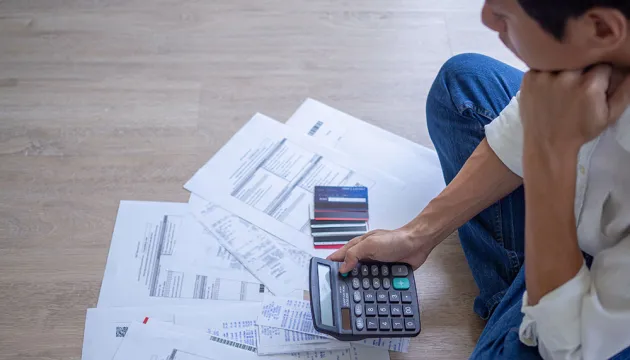How to Pay Off Credit Card Debt
When you need to reduce or eliminate your credit card debt, it helps to start by setting some goals and selecting a strategy. You could focus on paying off the largest balance first or start small and work your way up to the larger balance. The first option will help you pay down debt more quickly but may be a challenge for someone with limited funds. Consider automating your payments to avoid additional fees. Make sure you have the funds available to avoid non-sufficient funds (NSF) fees. Be sure to review your spending habits to and cut back where possible to free up more money for debt repayment.

Cost of Minimum Payments on Credit Cards: Real World Example
This example will show how a simple purchase, like a smartphone, can turn into years of debt if you only make the minimum payments.
Imagine you’ve got a new credit card and plan to treat yourself to the latest smartphone and a few accessories. The total cost will be $1,500 on your credit card, which has a 19% interest rate.

If your credit card requires minimum payment of 4% of the outstanding balance, your first payment will be at $60. At first, this might seem manageable, but it will take you more than 8 years to pay off that $1,500. Over the course of 106 payments, you’ll also end up paying more than $889 in interest. And that’s assuming you don’t add anything else to the card or incur late fees.

Now, imagine your card only requires a 2.5% minimum payment, which comes out to $37.50 a month. The lower payment may feel easier, but it means you’ll be stuck paying off that smartphone for over a decade. You’ll make 208 payments and over $2,138 in interest.

Paying the Minimum vs. Full Balance
Each month you receive a statement from your credit card servicer that outlines everything you’ve charged to that card during the previous billing cycle. Your statement also shows your credit card balance—what you owe. You may think you only have to pay the minimum payment due, which is lower than your full balance. But look closely at your balance information. It will tell you how long it will take to pay off your account balance if you only pay the minimum payment. In some instances, it can take years to pay off high balances. By paying your full balance every month, or at the very least trying to pay more than the minimum amount, you can pay off the debt sooner, avoid potential interest charges, and build good credit management habits.

Credit Card Features and Fees
There are many options a credit card may offer that can benefit you, such as earning reward points or discounts. These perks often come with a higher annual fee or interest rate. Cards without an annual fee may have higher fees or steeper penalties. Compare cards to get the features that meet your needs. Read your credit card statement to be aware of fees.
Balance Transfer Fee
Shifting your balance to a lower interest rate card may be a good move. Be aware there could be fees to transfer the balance. For example, with a common rate of 3% of the amount moved, transferring $1,000 would cost you $30. Some cards cap these fees, so compare options to see if a balance transfer is worth it.
Late Payment Fee
A card issuer is allowed to charge up to $27 for the first offense, and up to $38 for the next. Some card issuers use a sliding scale, so for any balance over $1,000, you could be charged the highest fee.
Annual Fee
Some credit cards charge annual fees that could be as high as $700, often in exchange for a rewards program. Other card issuers may advertise no annual fees to distract you from their other fees. Choose a card with a fee structure that is right for your circumstances.
Cash Advance Fee
This fee is often the greater of $10 or 5% of the cash advance. For instance, a quick $100 cash advance from an ATM might add a $10 minimum charge, since 5% of $100 is only $5.
Over-limit Fee
If you make charges on your credit card and exceed your approved limit, you might receive a hefty penalty fee. While the upper range can be as high as $38, the card issuer often uses a sliding scale.
Currency Exchange
If you make purchases outside the United States, your credit card company may add a 1% currency exchange fee. Some credit unions and banks tack on an additional 2%. Always check your card’s terms before making international purchases.
Returned Payment Fee
If you pay your credit card bill with a check that bounces, you may be charged a fee for not having enough funds to make the payment. It may also trigger a late payment fee if you are unable to pay the bill on time.
Other Uncommon Fees
A few credit cards charge small fees for additional services, such as sending a wire transfer, using overdraft protection, stopping a payment, mailing a statement, shipping a replacement card, or reinstating an inactive account.
Why Reading the Fine Print Matters
Each credit card has its own terms and likely fees, and you can find all the details about fees and charges in the cardholder agreement. If you do not fully understand what you need to pay, these fees can add up. Making your payments on time reduces overall fees and improves your credit management.
Security Tips
Consider these safety precautions to keep your cards secure:
- Never lend the card to anyone unsupervised or sign a blank charge slip.
- Draw lines through blank spaces on charge slips above the total so the amount can’t be changed.
- Never put your account number on the outside of an envelope or on a postcard.
- Always be cautious about disclosing your account number over the telephone, unless you know the person you’re dealing with represents a reputable company.
- Carry only the cards you expect to use to reduce potential loss or theft.
- If your card is lost or stolen, report it immediately to your card issuer. Follow up with a letter that includes your account number, when you noticed the card was missing, and when you first reported the loss.